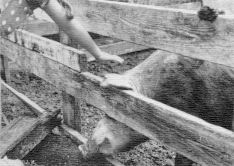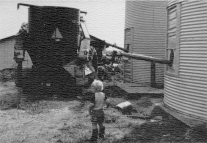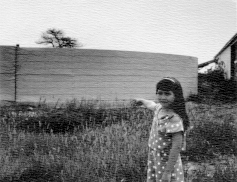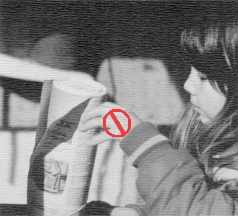 "Even
good-tempered animals can be dangerous. This kind of situation
can lead to injury".
"Even
good-tempered animals can be dangerous. This kind of situation
can lead to injury".
The statistics
are frightening! In just 10 years, 80 children under the age
of 15 were killed in Ontario farm accidents. Among these fatalities
were 61 youngsters aged 10 years or less. Thirty-nine were
under the age of five. In every case, a very young life was
cut short, and a family was left with a gap that can never
be filled.
Inherent
dangers
The very
nature of farming activities is what makes them so dangerous
to children. On the one hand, a farm is an industrial workplace,
filled with a bewildering variety of dangers. Yet it is also
a home, or a special place to visit. Children can not simply
be kept completely away from the workplace, as is the case in
other industries. Instead, farm families must identify the many
hazards and find ways of dealing with them.
Hazards encountered on a farm are extremely varied. They range from electric shock, to poisoning, to bad-tempered livestock. The hazards also change--for example, a stubble field may be a good, safe place for a walk. A few days earlier--during harvesting--the same field would have been filled with danger.
Machinery
Most children killed or injured on farms are victims of machinery accidents.
Many
of these tragedies occur when an operator starts a machine
without even knowing a child is in the area. In other cases,
the neglect is more obvious--for example, when a child falls
from an implement or a tractor fender.
Hazardous
materials
A majority of farm chemicals are quite dangerous. If children (especially small children) get their hands on such materials, the results can be quite tragic. The same is true with more commonplace items, such as gasoline and matches.
Building
and other structures
Buildings can be designed to be safe, and should be fixed if they are unsafe. However, sloppiness can defeat the safest design. For example, a farm child died when he tried climbing a tractor wheel that was leaning against a wall, and the wheel fell on him. Another youngster died when some old baler twine hanging from a beam caught around his neck.
Livestock
Even good-tempered animals can become dangerous. For example, a toddler could be knocked down and trampled by cattle that would hardly notice the child's presence. Even the quietest animals can become dangerous if they feel threatened, particularly if they have their young with them.

"Know
where children are at all times. Young children must
be supervised".
Accidents involving children
can be prevented through attention to details, based on a good understanding of some of the fundamental principles:
Make
equipment and buildings safe
Anything that is hazardous to you--for example, a hole in a barn floor or a protective shield left off a machine--is also a danger to children. However, simply making a farm safe for adults is not enough. Children are extremely curious, but lack adult judgment. They also may be small enough to get past protective barriers and shields that would stop most grown-ups.
Dangerous
equipment, materials should be inaccessible
Anything children might use to harm themselves or others should always be kept out of reach. Guns and pesticides are obvious examples.
Know
where children are at all times
This is difficult on a modern farm, since both parents often have to join in the work. However, young children
must be supervised. If both parents are working, daycare or some other form of adult supervision is essential.
Practice
safety
Have you ever set down a container of pesticide for "just a second," and ended up leaving it for several hours? The best planning and intentions only pay off if safety is practiced every day.
Set
a good example
When children start to help out on the farm, they will follow your example. If you work safely, so will they.
Educate
Even small children can learn the rudiments of safety, such as which areas of the farm are "off limits." As they get older, children can learn why certain things are dangerous. School programs and safety publications designed specifically for children enhance the learning process.
Don't
ask too much
When youngsters do begin helping with farm work, proper training is essential. Adults should keep in mind a child's limited strength and experience. (How often will a teenager actually admit that they "don't know" or "aren't strong enough?")
It is
especially easy to assume that the safe way of doing something
is obvious. Instead, it is only because of the farmer's wealth
of experience that it seems obvious. For the youngster,
everything about safety has to be explained, and then
explained again.
Anticipate
lapses
Even the best kids can disobey or forget. Similarly, well supervised children will occasionally end up where they don't belong. Taking children for granted--for example, leaving a can of pesticide out because you assume that a youngster "knows better"--can be extremely dangerous.

"Anything
that is hazardous to you--is also a danger to children. Remove
hazards where possible".
The
most important safety rule on the farm is NO PASSENGER--EVER!
An Ontario
study showed that 13 child fatalities were passengers on tractors
or on implements connected to tractors. The great tragedy
is that these accidents could so easily have been prevented.
You have
to be firm! Refuse to give in to requests for a ride "just
across the barnyard." Allow enough time for helpers to walk
to and from fields, or provide a safe means of transport.
Machinery
should be maintained in good repair, with all protective shields
in place. Children must understand that they are not allowed
to play with idle machinery. Equipment that might fall--such
as front-end loaders--should be left in the down position.
When self-propelled machinery is parked, brakes should be
locked and keys removed from the ignition. Tractor PTO's should
always be left in neutral. When starting machinery--and especially
when reversing--you should always know where the children
are.
Kids
should not be allowed to operate machinery until they are
big enough to easily reach all of the controls. They
should be thoroughly trained in the safe operation of equipment
before start-up. When training beginners, have them explain
things back to you, using their own words. If they seem confused,
take the time to go over things again and again, until you
are sure they understand. Something that seems obvious to
you may be very confusing to a beginner.
 MAKE
WORK AREAS 'OFF LIMITS'
MAKE
WORK AREAS 'OFF LIMITS'
Until they are old enough to begin helping, children should not be allowed in areas where work is underway. An operator simply can not operate a machine properly and watch for children at the same time. This is true for fieldwork, as well as for work around buildings.
"Children
must understand that they are not allowed to play with
idle machinery".

"Make
hazardous areas such as manure pits inaccessible to children
by fencing them".
Exceptions
can be made to show children the type of work being done.
However, they should be kept in a group, and should always
be accompanied by an adult. It should be emphasized that they
are there to watch, not to play or run around. The accompanying
adult should be careful to keep the children a safe distance
away from any danger.
Safety
can be built into structures
Some farm structures are extremely hazardous to children. The most dangerous of these include:
- Silos,
with their deadly gases and unloading equipment.
- Binned
grain can turn into quicksand, particularly during bottom
unloading. (Children have also 'drowned' in grain as bins
were being filled.)
- Farm
ponds and open liquid manure storage facilities are
potential drowning sites.
- Stationary
machinery, such as feed mills.
- Electrical
boxes and wiring.
- Anywhere
high enough to produce a dangerous fall.
The only
way to make any of these areas safe for children is to make
them inaccessible. In some cases, this requires special fencing--for
example, around manure pits. The fencing should be designed
to prevent children squeezing through or climbing over.
The bottoms
of fixed ladders should be out of reach, or fitted with a
special barrier. Portable ladders should be stored away from
danger areas such as silos.
Where
protective barriers are needed, they should be fitted properly
and designed so that small children cannot squeeze through.
Dangerous machinery components and electrical boxes and wiring
should be properly shielded. They should be placed out of
the reach of small children, or be fitted with locking devices.

"Dangerous
materials such as pesticides should be stored in a locked
cabinet or shed".
Safe
designs have to be supported by safe habits. Many children have
been injured by simply tripping over objects left lying on the
ground. Others have been hurt when they became tangled in old
fence wire or baler twine. Anything you want to keep should
be stored neatly; everything else should go to the dump. This
rule applies not just to the farmyard, but also to fence rows
and fields.
When
storing things, be careful not to create new hazards. For
example, a couple of bales of straw stored under a fusebox
can put the box within a toddler's reach. Also, heavy objects
should never be left leaning against walls or posts. Children
will try to climb them and may fall or even pull the objects
over on top of themselves.
Dangerous
materials, such as pesticides and other toxic chemicals, should
be stored in a locked cabinet or shed in their original containers.
When a container is empty, it should be rinsed out and disposed
of as soon as possible. If there is not enough room to securely
store treated seed and fertilizer, children should be warned
of the dangers in the strongest possible terms. In identifying
hazardous materials, be careful not to overlook everyday items,
such as matches.
Guns
should be stored unloaded in a place where they are
out of childrens' reach. Ammunition should be stored in a
separate place that can be locked. When in use, guns should
never be left unattended, even for "just a second."
As
children mature, there are changes in the nature of supervision
that are required. In the early years, children simply can not
be left alone. If both parents are working, someone else--a
babysitter, a relative, or a rural day care service--
must
be found. At this age, a fenced play area near the house will
make supervision easier. However, an adult should still be close
at hand.
As children
get older, the need for direct supervision decreases. However,
basic rules--for example, to stay away from areas where work
is underway--are still needed. Adults must be patient and
allow enough time to enforce the rules.
When
older children begin helping on the farm, a different kind
of supervision is needed. The days of simply making areas
off limits are gone. Instead, parents must watch to make sure
work is being done safely. Whenever safety rules are broken,
adults must make time for explanation and enforcement.
It's
in your hands
Remember that children sometimes are careless, and may forget. They may try to do too much, and sometimes deliberately disobey. In the end, safety is the responsibility of adults. No matter how carefully they are taught, children
are still children.
Publication #: F-018
The information
and recommendations contained in this publication are believed
to be reliable and representative of contemporary expert opinion
on the subject material. The Farm Safety Association does not
guarantee absolute accuracy or sufficiency of subject material,
nor can it accept responsibility for health and safety recommendations
that may have been omitted due to particular and exceptional
conditions and circumstances.
Farm
Safety Association Home Page
Disclaimer and Reproduction Information: Information in
NASD does not represent NIOSH policy. Information included in
NASD appears by permission of the author and/or copyright holder.
More
 "Even
good-tempered animals can be dangerous. This kind of situation
can lead to injury".
"Even
good-tempered animals can be dangerous. This kind of situation
can lead to injury".


 MAKE
WORK AREAS 'OFF LIMITS'
MAKE
WORK AREAS 'OFF LIMITS'
